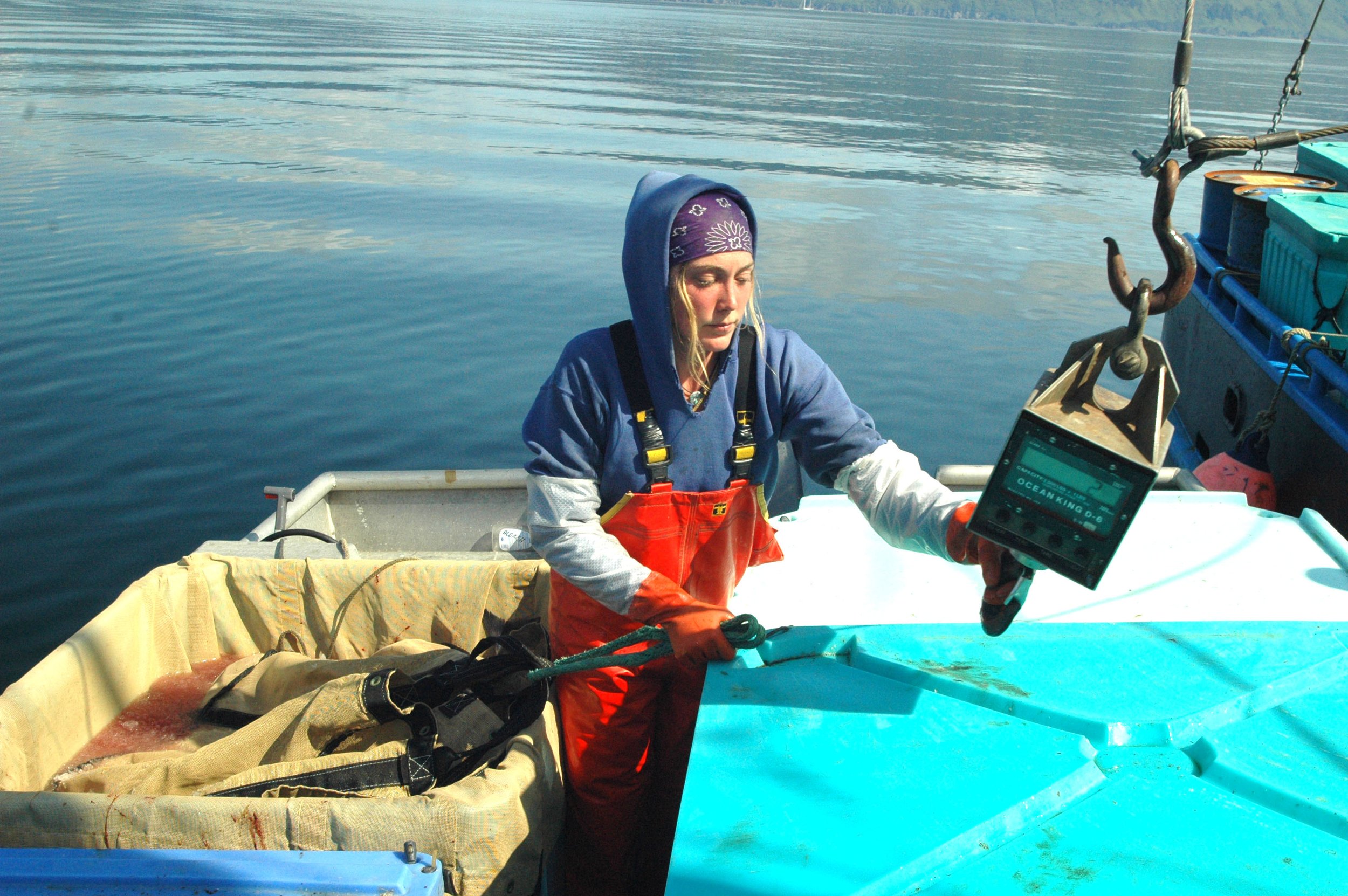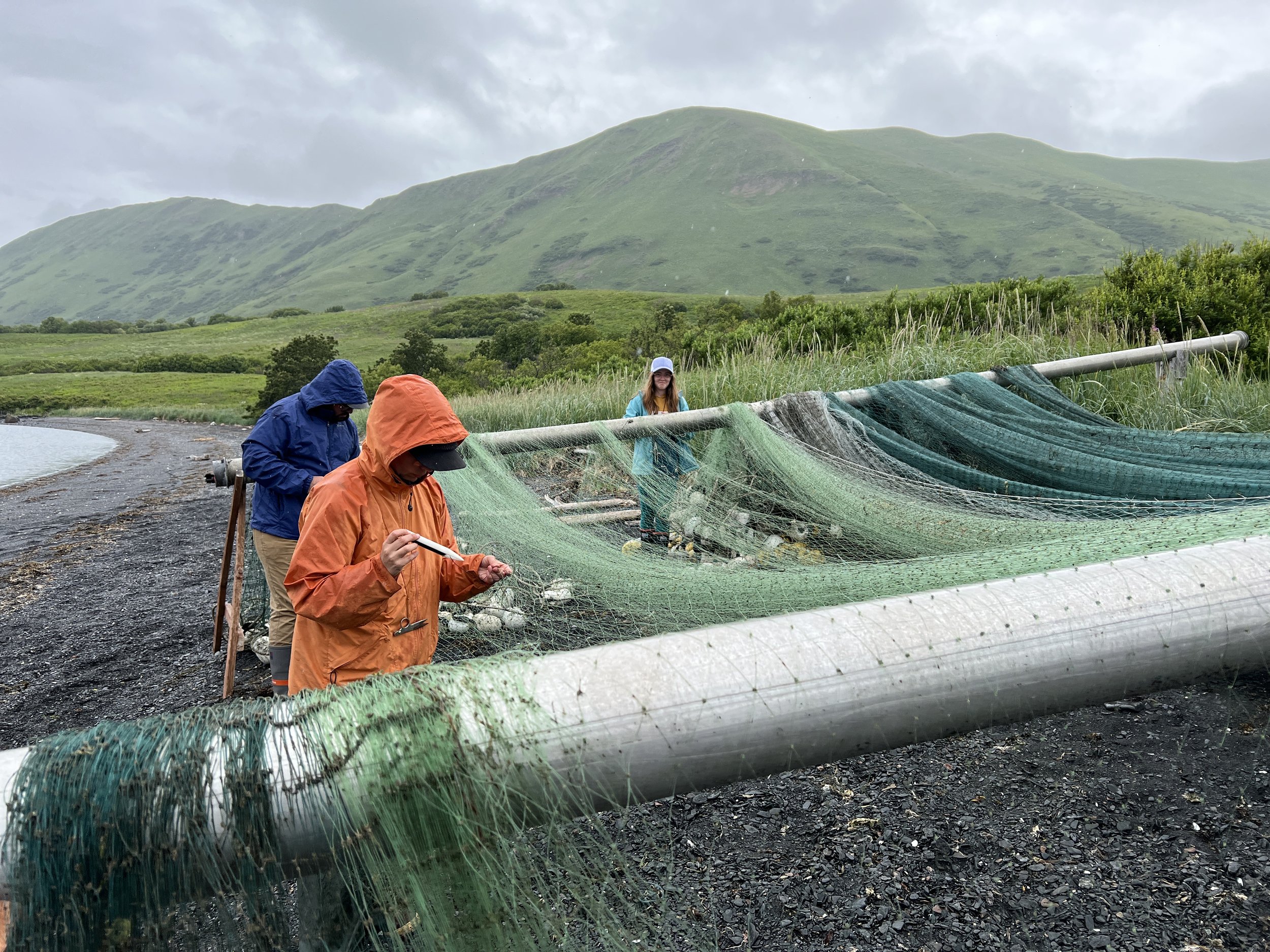
What We Do
Preparation
Setnetting for wild Pacific salmon on Kodiak Island is both a job and a way of life. Many sites are multigenerational, with families returning for decades to remote cabins where they catch salmon with set gill nets extending from the shore, picking each fish by hand from the skiff. It can be an extremely long salmon season on Kodiak, late May through September. Fishing typically opens the first week of June and wraps up by mid-September. It’s challenging to find crew who can return year after year for that length of time, which means that a lot of energy goes into training at the start of each summer. New crew must learn a variety of knots, the basics of what the tide is capable of, skiff handling and safety, how to differentiate between species, how to untangle salmon from the net, how to mend nets by patching holes, and how to build new nets. Crewmen share in the meals and daily chores at these remote cabin sites.
To open the fishsite each spring, we take down electric fences, remove boards from cabin doors and windows, hook up water lines. Electricity comes from generators or solar panels and inverters. On the beach, we take everything out of storage and go through shore leads, fix holes, and get cork rubbers or ties on every net. There’s a lot of freight hauling at the beginning of each season—new gear, dry groceries, and various supplies for fishing and living. Generally water is heated and cooking is done using propane; it can be challenging carrying 100 pound bottles of propane up rocky beaches to the cabin. Fuel is needed for pressure washers, outboards and other equipment. It arrives by tender, a large fishing vessel that delivers supplies and transports fish delivered by fishermen to processors around the island, or might be run from town by skiff. Many setnetters put out a running line -a pulley system from shore to deep water - to moor their skiffs. It can take several days to drop anchors in preparation for the season. Each net has at least 5 anchors on it, most have more than that. There may be as many as 10 or more anchors.
Openers
Fishing seasons are dependent upon the strength of salmon runs and the number of days that the Alaska Department of Fish & Game salmon managers determine will balance catch with sustainability. The day before an opener, we set our shore leads and make ice or get it from a tender. Some setnetters use a refrigerated seawater system for chillig their fish. Ice machine maintenance means priming water systems, fixing water leaks, and making sure pressure tanks and pumps are working. We fuel up skiffs, either from a tender or from our own fuel tanks. Totes are pressure washed with brailer bags ready. The morning of an opener, we load the skiffs with nets. It’s sometimes a huge job to clear kelp off a set before openers. When the kelp is especially heavy, it means going out at night and early mornings just to cut kelp. When fishing opens, the crew heads out and ties sets as fast as possible, loading ice totes into the skiff with brailer bags of slush ice to hold the salmon. The work of picking each salmon from the net is done in all types of weather and sea conditions. Hours on the water can vary wildly depending on the volume of salmon, but 16 hours days are not uncommon if the fishing is heavy.
On the nets
Most setnet skiffs are aluminum and around 25 feet. The net is placed over the roller and out over the stern of the skiff and the skiff is driven along the net while crews of two or three pick salmon out of the net as they come into the skiff. Some portions of the net may have to be picked from the side of the skiff. Crew is on the nets all day, picking multiple times a day, removing debris each time and delivering the catch to a tender. Setnetters do that day in and day out while it’s open.
As well as picking fish, the crew cleans most nets daily with a pressure washer or volume pump from the skiff, shaking out kelp, slime, and stinging jellyfish. Setnetting can be messy, tedious, and monotonous. During big storms, tide and winds may break lines or drag anchors. Then we’re doing repairs on the water, setting new anchors and making adjustments. No matter the weather, you’re tending your net and keeping it free of floating debris. The work is physically demanding. It can also be incredibly rewarding, with humpbacks or orcas breaching nearby, seals and otters floating past, oyster catchers, ducks, puffins and eagles calling overhead, sunrises and sunsets set against mountains and always changing seas, and the camaraderie of working closely with others outside in a wild, beautiful place.
On the beach
When there’s a closure, we start pulling nets with enough time to have everything out of the water by the hour set by ADF&G. The time that takes depends on the number of nets, winds, tides and quantity of fish. We haul nets from the skiff up the beach. Then pressure wash them clean and get them ready for the next opener. It can take several days of work to mend all the holes. In any extra downtime, we’ll build more nets throughout the season. There may be wood to chop for banyas and wood stoves, or fish to filet for dinner. There may also be time for naps, reading and card games, or for skiff rides, halibut fishing, berry picking, gardening, hiking, kayaking, and gatherings with others around the bay for picnics, potlucks and bonfires.
End of the season
In many ways, the work starts when we finish fishing for the year. We pull nets for the last time and wrap them for winter, winterize pressure washers, generators, ice machines, tractors, all of the outboards, any battery systems, and change coolant in generators. Then pressure wash every buoy, anchor line, tote and boat. We pull skiffs from the water and pack everything away so that it’s ready to use again the following season. Many sites put up their own home pack–each bright fillet pulled from the freezer a reminder of summertime and the promise of the next salmon season.




























